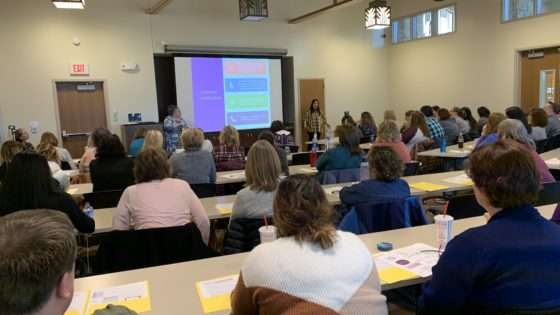One out of three women and one in four men have experienced some form of domestic violence. Nine out of ten victims say they would like to pursue child support, if they could do so safely. So, how can child support workers get victims the help they need while ensuring their safety? CWRTP teamed up with Iowa’s Child Support Recovery Unit and the Iowa Coalition Against Domestic Violence to teach over 300 child support workers how.
In late October and November, six training sessions were held at the Fred Maytag II Scout Center in Des Moines. Each session hosted Iowa Child Support Recovery Unit staff members from the entire state. The goal was to provide CSRU staff with resources to improve their ability to perform their job as it relates to domestic violence cases.
Martha Stewart and Jay Grey are Instructional Development Specialists for CWRTP. They organized and executed the six sessions. Stewart provided details on some of the benefits case workers took away from the training:
“[Benefits included] a broader understanding of domestic violence and how victims may react to their circumstances. Any form of trauma can cause people to act in counter-intuitive ways that may frustrate those who are trying to help them.”
CSRU workers need to be able to recognize more signs than scrapes and bruises. Domestic violence can take many forms, including psychological abuse, stalking, threats, and economic abuse, as well as physical abuse.
The training included videos of parents who escaped real domestic violence situations discussing their experience. These videos delivered a visceral understanding of those types of situations and how they can manifest.
A simulation allowing participants to walk through similar, real-life situations continued to build this understanding. Participants were required to react to situations and make decisions that affected the outcome of their story, with the goal to increase understanding of victims’ decision-making processes even more. Speaking about the simulation, one participant commented, “The obstacles a person can run up against are not always what you would expect.”
Experts from the Iowa Coalition Against Domestic Violence discussed victims who made decisions that might seem surprising to the average person. They explained how these types of decisions could make perfect sense to a person on the inside of a violent relationship. The experts did a great job describing victims’ mindsets and told workers to ask victims what would be helpful, rather than telling them what to do.
During the last session, one CSRU worker stood up and asked to tell a story. He proceeded to tell the group about a domestic violence victim he knew personally who was murdered by her ex-partner.
“She thought she had done all the right things,” he said. Others in the room also knew the woman he spoke of, which created a powerful moment as everyone realized how serious and real the issue of domestic violence is.
Speaking to the importance of this training, Stewart stated, “With understanding and recommendations about how to approach victims in a constructive way, it's possible for case workers to increase their own and their clients’ safety, reduce their own frustration level, and learn ways to communicate with customers so that cooperation is more likely.”

